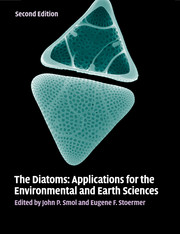Book contents
- Frontmatter
- Contents
- List of contributors
- Preface
- Part I Introduction
- Part II Diatoms as indicators of environmental change in flowing waters and lakes
- Part III Diatoms as indicators in Arctic, Antarctic, and alpine lacustrine environments
- Part IV Diatoms as indicators in marine and estuarine environments
- Part V Other applications
- 24 Diatoms of aerial habitats
- 25 Diatoms as indicators of environmental change in wetlands and peatlands
- 26 Tracking fish, seabirds, and wildlife population dynamics with diatoms and other limnological indicators
- 27 Diatoms and archeology
- 28 Diatoms in oil and gas exploration
- 29 Forensic science and diatoms
- 30 Toxic marine diatoms
- 31 Diatoms as markers of atmospheric transport
- 32 Diatoms as non-native species
- 33 Diatomite
- 34 Stable isotopes from diatom silica
- 35 Diatoms and nanotechnology: early history and imagined future as seen through patents
- Part VI Conclusions
- Glossary, acronyms, and abbreviations
- Index
- References
33 - Diatomite
from Part V - Other applications
Published online by Cambridge University Press: 05 June 2012
- Frontmatter
- Contents
- List of contributors
- Preface
- Part I Introduction
- Part II Diatoms as indicators of environmental change in flowing waters and lakes
- Part III Diatoms as indicators in Arctic, Antarctic, and alpine lacustrine environments
- Part IV Diatoms as indicators in marine and estuarine environments
- Part V Other applications
- 24 Diatoms of aerial habitats
- 25 Diatoms as indicators of environmental change in wetlands and peatlands
- 26 Tracking fish, seabirds, and wildlife population dynamics with diatoms and other limnological indicators
- 27 Diatoms and archeology
- 28 Diatoms in oil and gas exploration
- 29 Forensic science and diatoms
- 30 Toxic marine diatoms
- 31 Diatoms as markers of atmospheric transport
- 32 Diatoms as non-native species
- 33 Diatomite
- 34 Stable isotopes from diatom silica
- 35 Diatoms and nanotechnology: early history and imagined future as seen through patents
- Part VI Conclusions
- Glossary, acronyms, and abbreviations
- Index
- References
Summary
Introduction
Diatomite, a soft, porous, fine-grained, lightweight, siliceous sedimentary rock, is produced by the accumulation and compaction of diatom (Class Bacillariophyceae) remains. The cell wall of living diatoms is impregnated with silica (amorphous hydrous, or opaline (SiO2.nH2O)), which preserves ornate and highly porous structures (Armbrust, 2009). Upon death of the organism, these siliceous elements become sedimentary particles in a diatomite deposit. The intricate structure of diatom frustules, and packing of the myriad diatom shapes into rock-forming sedimentary layers, gives diatomite deposits properties that are useful in many industrial and commercial applications. Most diatoms are 10 μm to 100 μm in size, although larger species reach more than 1 mm (Tappan, 1980) and smaller ones are <2 μm. This small size results in large concentrations of diatoms; a cubic inch of diatomite may contain 40 to 70 million diatoms (Crespin, 1946). Although the specific gravity (density) of the SiO2 that comprises the diatom particles is nearly twice that of water, perforations and open structures in the frustule renders diatomite a considerably lower effective density (between 0.12 g cm–3 and 0.25 g cm–3) with high porosity (from 75 to 85 percent). This sedimentary rock is able to absorb and hold up to 3.5 times its own weight in liquid (Cleveland, 1966). These properties bring industrial utility and commercial value to rock-forming accumulations of diatom remains.
Diatomite deposits of varying quality are known from freshwater and marine sedimentary environments (Moyle & Dolley, 2003). Other names for diatomite and diatomaceous earth include tripoli, kieselguhr, and infusorial earth.
- Type
- Chapter
- Information
- The DiatomsApplications for the Environmental and Earth Sciences, pp. 570 - 574Publisher: Cambridge University PressPrint publication year: 2010
References
- 8
- Cited by



